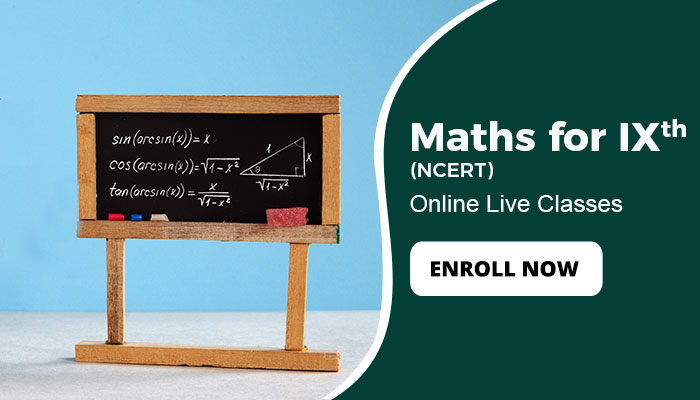SYLLABUS
1. NUMBER SYSTEMS
1.1 Introduction
1.2 Irrational Numbers
1.3 Real Numbers and their Decimal Expansions
1.4 Representing Real Numbers on the Number Line
1.5 Operations on Real Numbers
1.6 Laws of Exponents for Real Numbers
1.7 Summary
2. POLYNOMIALS
2.1 Introduction
2.2 Polynomials in One Variable
2.3 Zeroes of a Polynomial
2.4 Remainder Theorem
2.5 Factorisation of Polynomials
2.6 Algebraic Identities
2.7 Summary
3. COORDINATE GEOMETRY
3.1 Introduction
3.2 Cartesian System
3.3 Plotting a Point in the Plane if its Coordinates are given
3.4 Summary
4. LINEAR EQUATIONS IN TWO VARIABLES
4.1 Introduction
4.2 Linear Equations
4.3 Solution of a Linear Equation
4.4 Graph of a Linear Equation in Two Variables
4.5 Equations of Lines Parallel to x-axis and y-axis
4.6 Summary
5. INTRODUCTION TO EUCLID’S GEOMETRY
5.1 Introduction
5.2 Euclid’s Definitions, Axioms and Postulates
5.3 Equivalent Versions of Euclid’s Fifth Postulate
5.4 Summary
6. LINES AND ANGLES
6.1 Introduction
6.2 Basic Terms and Definitions
6.3 Intersecting Lines and Non-intersecting Lines
6.4 Pairs of Angles
6.5 Parallel Lines and a Transversal
6.6 Lines Parallel to the same Line
6.7 Angle Sum Property of a Triangle
6.8 Summary
7. TRIANGLES
7.1 Introduction
7.2 Congruence of Triangles
7.3 Criteria for Congruence of Triangles
7.4 Some Properties of a Triangle
7.5 Some More Criteria for Congruence of Triangles
7.6 Inequalities in a Triangle
7.7 Summary
8. QUADRILATERALS
8.1 Introduction
8.2 Angle Sum Property of a Quadrilateral
8.3 Types of Quadrilaterals
8.4 Properties of a Parallelogram
8.5 Another Condition for a Quadrilateral to be a Parallelogram
8.6 The Mid-point Theorem
8.7 Summary
9. AREAS OF PARALLELOGRAMS AND TRIANGLES
9.1 Introduction
9.2 Figures on the same Base and Between the same Parallels
9.3 Parallelograms on the same Base and between the same Parallels
9.4 Triangles on the same Base and between the same Parallels
9.5 Summary
10. CIRCLES
10.1 Introduction
10.2 Circles and its Related Terms : A Review
10.3 Angle Subtended by a Chord at a Point
10.4 Perpendicular from the Centre to a Chord
10.5 Circle through Three Points
10.6 Equal Chords and their Distances from the Centre
10.7 Angle Subtended by an Arc of a Circle
10.8 Cyclic Quadrilaterals
10.9 Summary
11. CONSTRUCTIONS
11.1 Introduction
11.2 Basic Constructions
11.3 Some Constructions of Triangles
11.4 Summary
12. HERON’S FORMULA
12.1 Introduction
12.2 Area of a Triangle – by Heron’s Formula 199
12.3 Application of Heron’s Formula in finding Areas of Quadrilaterals
12.4 Summary
13. SURFACE AREAS AND VOLUMES
13.1 Introduction
13.2 Surface Area of a Cuboid and a Cube
13.3 Surface Area of a Right Circular Cylinder
13.4 Surface Area of a Right Circular Cone
13.5 Surface Area of a Sphere
13.6 Volume of a Cuboid
13.7 Volume of a Cylinder
13.8 Volume of a Right Circular Cone
13.9 Volume of a Sphere
14. STATISTICS
14.1 Introduction
14.2 Collection of Data
14.3 Presentation of Data
14.4 Ggraphical Representation of Data
14.5 Measures of Central Tendency
14.6 Summary
15. PROBABILITY
15.1 Introduction
15.2 Probability – an Experimental Approach
15.3 Summary
APPENDIX – 1 PROOFS IN MATHEMATICS
A1.1 Introduction
A1.2 Mathematically Acceptable Statements
A1.3 Deductive Reasoning
A1.4 Theorems, Conjectures and Axioms
A1.5 What is a Mathematical Proof?
A1.6 Summary
APPENDIX – 2 INTRODUCTION TO MATHEMATICAL MODELLING
A2.1 Introduction
A2.2 Review of Word Problems
A2.3 Some Mathematical Models
A2.4 The Process of Modelling, its Advantages and Limitations
A2.5 Summary


